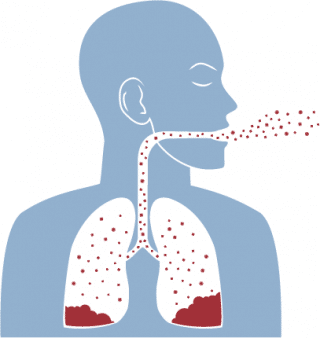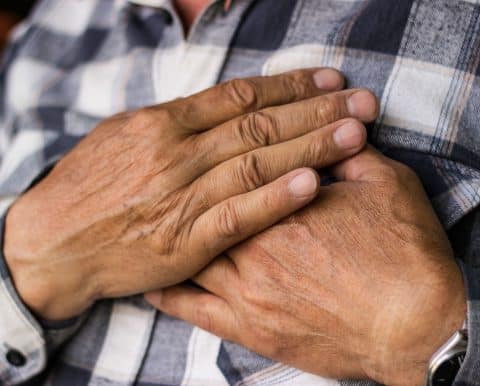What Is Asbestosis?
Asbestosis is a chronic lung condition caused by asbestos exposure and characterized by the formation of scar tissue in the lungs.

The disease can occur when a person breathes in tiny, toxic asbestos fibers. The dangerous fibers become trapped in the lung, and the lung tries unsuccessfully to remove the asbestos. This in turn leads to lung damage and scar tissue, which make it tough to breathe.
Symptoms of asbestosis worsen over time and often lead to respiratory failure and other deadly complications. To date, there is no cure for asbestosis.(1)
Symptoms of Asbestosis
Signs and symptoms of asbestosis may not arise for 10 to 40 years or more after exposure to asbestos.(2) This is called the latency period.
After a person has been exposed to asbestos, scar tissue develops for many years. Scarred tissue prevents the lungs from expanding and contracting normally, making it hard to breathe.(3)
Shortness of breath with physical activity is the main symptom of asbestosis. People with asbestosis also may feel fatigued or experience a persistent dry cough.(4)

Other symptoms of asbestosis include:
- Chest tightness.
- Chest pain.
- Weight loss.
- Loss of appetite.
- Wider and rounder than normal fingertips and toes, known as clubbing.(5)
Anyone who experiences symptoms of asbestosis should consult a doctor immediately. Asbestosis patients may also choose to contact an experienced asbestos attorney to discuss their legal options.
Possible Complications of Asbestosis
As asbestosis progresses over time, it can become harder to breathe, even after the exposure to asbestos stops. Eventually, asbestosis patients may require treatment that provides them with extra oxygen to help them breathe.
Sadly, there is no cure for asbestosis, and the disease may lead to lung or heart failure.(6) Asbestosis is one of a number of asbestos diseases including:
- Malignant mesothelioma: cancer of the lining of the lungs and other organs.
- Lung cancer: a malignant tumor that invades the lungs.
- Pleural effusion: a buildup of fluid around the lungs.
- Pleural plaques: thickening and hardening of the lining of the lungs.(7)
The severity of the asbestosis generally depends on the amount of time a person was exposed to asbestos and how much asbestos that person inhaled.(8)
Asbestosis Diagnosis & Treatment
To diagnose asbestosis, a doctor will likely ask patients about their jobs, to determine the extent of their asbestos exposure, and about their breathing, both at rest and during activity. The doctor usually uses a stethoscope to listen to the lungs and may hear a crackling sound when patients with asbestosis inhale.

Doctors may also order tests, including:
Breathing tests.
Chest X-ray.
Computerized tomography (CT) scan of the chest.
If an asbestosis diagnosis is confirmed, a doctor may recommend treatment options to relieve symptoms or slow the disease’s progress. Weitz & Luxenberg does not provide medical advice, and the decision of which treatment options are best in any given situation is a matter between a patient and his or her doctors.
Some doctors may prescribe medications to thin lung fluids or recommend procedures to remove fluids from the lungs. People with asbestosis may require oxygen either by mask or by a plastic piece that fits into the nostrils. In a severe case, an asbestosis patient may need a lung transplant.(9)
Have you or your loved one suffered complications due to asbestos exposure? Contact us now for a free consultation.
Get a Free Case ReviewWho Gets Diagnosed with Asbestosis
Many Americans who are diagnosed with asbestosis were exposed to asbestos before the 1970s, which is when the health consequences of asbestos exposure lead the U.S. Occupational Safety and Health Administration (OSHA) to impose severe restrictions on exposures.
Prior to that time, companies used asbestos widely as an insulator and fire retardant, particularly in the construction, automotive, manufacturing, and shipbuilding industries.(10) Some members of the U.S. military and family members of asbestos workers also encountered the toxic fibers.
Despite current federal regulations, asbestos may still be present in older homes and public buildings, including schools. As a result, demolition workers, drywall removers, asbestos removal workers, and firefighters, among people in other occupations, continue to be at risk of asbestos exposure.
In addition, construction workers, automotive workers, and laborers in other industries still face significant exposure in the workplace.(11)
Filing an Asbestosis Lawsuit
Years or decades have gone by since you were first exposed to asbestos dust, and now you are facing an asbestosis diagnosis. You may be unsure of your legal options for seeking compensation, and filing a lawsuit after all these years can seem daunting. We are here to help.
Weitz & Luxenberg’s trusted asbestos attorneys will track down the source of your asbestos exposure and handle the legal burden so that you can focus on your health and the people you love.
Having represented more than 33,000 individuals and families affected by asbestos exposure, we have developed winning methods to convey to juries the complex scientific and medical issues involved in asbestos cases.
Were you or a loved one diagnosed with mesothelioma? Call for a free legal consultation.
(833) 977-3437Request Help Today
Weitz & Luxenberg offers a team of nearly 100 attorneys, many solely focused on asbestos cases. Over the past three decades, we have provided exceptional and caring legal support to asbestos victims and surviving loved ones, winning $8.5 billion in asbestos settlements and litigation.*
With multiple office locations, we successfully represent clients across the U.S., handling more than 500 cases annually. Our comprehensive Client Relations department is on call 24/7 to answer questions and ensure that all your needs are met efficiently.
For a free legal consultation and to learn more about your legal options, please contact our office at (833) 977-3437 or fill out a form to speak to one of our asbestos attorneys.
